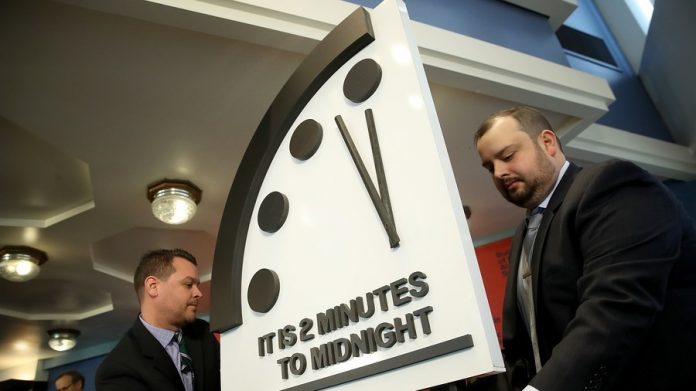A global catastrophe is but two minutes away, according to the Doomsday Clock, which measures, metaphorically, how long the world has left before it succumbs to a man-made disaster.
Managed by the Bulletin of Atomic Scientists, a group of scientists and academics, the clock was moved 30 seconds on Thursday. The clock’s hands had been at two-and-a-half minutes to midnight in 2017.
Rachel Bronson, Bulletin of the Atomic Scientists CEO, said this year that nuclear weapons and the unpredictability of nations holding them were a significant consideration.
“All of the major weapons states are investing in their nuclear arsenals,” said Robert Rosner, research professor in the Department of Astrophysics and Physics at the University of Chicago.
“North Korea’s nuclear and missile tests demonstrated an accelerating of building a new generation of weapons of mass destruction. In South Asia, the emphasis on missile capabilities grows.
“The nuclear arsenals of all of the major weapons states are being updated and imbued with enhanced capabilities. The Trump administration’s Nuclear Posture Review appears likely to increase the types and roles of nuclear weapons in US defense plans,” he added.
Sharon Squassoni, from George Washington University, said US-Russian relations were a vital element to the board’s decision.
“Both countries still possess about 95 percent of the world’s nuclear weapons, and without bilateral progress, there is little incentive for others to move forward. However, for the first time in many years no US-Russian nuclear arms control negotiations are underway,” Squassoni said.
“If the draft US Nuclear Posture Review is any guide to US policy, there will be no US-Russia nuclear arms control negotiations for the foreseeable future. Instead, we could see a return to a nuclear arms race.”
Set for official release in February, a leaked draft of the US review on nuclear strategies indicated that it would push to develop more ‘low-yield’ nukes due to concerns over China, Iran, and Russia’s capabilities.
For decades the clock has been used as an ominous reminder of how close humanity is to destroy the world. Midnight represents total disaster or an apocalypse.
Decided initially on by Bulletin Editor Eugene Rabinowitch, the clock is now in its 71st year. Its settings are now based on an academic board’s view on the advancement of nuclear arms, climate change, and artificial intelligence.
The Doomsday Clock originally featured in a magazine back in the 1940s, when the development of nuclear arms first became a global fear. In its first outing, the clock read seven minutes to midnight. The furthest away from midnight it has ever been coming in 1991 after the end of the Cold War – when it struck 17 minutes to midnight.
Earlier this year, the Bulletin’s Nuclear Notebook warned of North Korea’s nuclear missile potential.
“Based on available information, we cautiously estimate that North Korea might have produced sufficient fissile material to build 30 to 60 nuclear weapons and that it might have assembled 10 to 20 warheads,” the report, co-written by Federation of American Scientists researcher Hans M Kristensen, stated.






